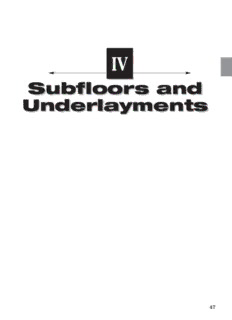
Subfloors and Underlayments Subfloors and - Armstrong PDF
Preview Subfloors and Underlayments Subfloors and - Armstrong
IV SSuubbfflloooorrss aanndd UUnnddeerrllaayymmeennttss 47 IV. Subfloors and Underlayments A.GRADELEVELS 1.Suspended—Asuspendedfloorisonewithaminimumof18 of ″ well-ventilatedairspacebelow. 2.On-grade—Anon-gradefloorisindirectcontactwithgroundoroverafill indirectcontactwithground.Aslabongroundlevelisanexample. 3.Below-grade—Abelow-gradefloorispartiallyorcompletelybelowthe surroundinggradelevelindirectcontactwithgroundoroverafillin directcontactwithground. Suspended Ongrade Grade Level Below Grade Level grade ↑ Moisture ↑ Moisture B.DEFINITIONS 1.Subfloor—Asubfloorisselectedforstructuralpurposesandisthe substrate(supportinglayer)fortheunderlayment. 2.Sleeper-constructedsubfloor—Consistsofwoodsubfloorinstalledover oronanexistingconcretesubflooronorbelow-gradewithout18 ofwell ″ ventilatedairspace. 3.APAtrademarked—Woodunderlaymentsapprovedassuitableforthe installationofresilientflooringbyAPA--TheEngineeredWoodAssociation. 4.STURD-I-FLOOR—AnAPAperformanceratedpanelspeciallydesigned ascombinationsubfloor/underlayment. 5.Underlayment—Thesmoothsurfaceusedasthesubstrateforthefloor covering. 6.Subfloor/UnderlaymentCombination–Asurfacethatmustmeetstructural requirementsandhaveasmoothsurfacesuitableforthefloorcovering. 7.Substrate—Thesmoothsurfacepreparedtoaccepttheresilientfloor covering,suchasconcrete,underlaymentorexistingresilientfloorcovering. 48 ChapterIV—SubfloorsandUnderlayments RegardlessofthetypeofunderlaymentusedunderArmstrongresilient flooring,theresponsibilityforwarrantiesand/orperformanceguarantees fortheunderlaymentrestssolelywiththeunderlaymentmanufacturer and/orsupplierandnotwithArmstrong. Thetypesofsubfloorsandunderlaymentpanelsdescribedinthismanual (F-5061)areintendedonlyasaguideandshouldnotbeconstruedasan Armstrongwarrantyfortheseproducts. Armstrongcannotberesponsiblefor: jointortextureshow-through (cid:2) tunnelingandridgingoverunderlaymentjoints (cid:2) discolorationfromstainsourcesinthepanel,regardlessofthetypeof (cid:2) underlaymentpanelused underlaymentpanelproblemscausedbylocalclimateconditions, (cid:2) basementwallandsubfloorconstruction,orimproperinstallation Westronglysuggestthatyousecureawrittenguaranteeandinstallation instructionsfromthesupplierormanufactureroftheunderlaymentboard beingused. C.WOODSUBFLOORS Armstrongresilientfloorsarerecommendedonsuspendedwoodsubfloors withaminimumof18 ofwell-ventilatedairspacebelow.Armstrongdoesnot ″ recommendinstallingresilientflooringonwoodsubfloorsapplieddirectly overconcrete,oronsleeper-constructionsubfloors. Loadingrequirementsforsubfloorsarenormallysetbyvariousbuilding codesonbothlocalandnationallevels.TradeassociationssuchasAPA–The EngineeredWoodAssociationprovidestructuralguidelinesformeeting variouscoderequirements.Subfloorpanelsarecommonlymarkedwith spanratingsshowingthemaximumcenter-to-centerspacingininchesof supportsoverwhichthepanelsshouldbeplaced. 1.APA-RatedSTURD-I-FLOOR Panelscanbemanufacturedasconventionalplywood,asacompositeor asorientedstrandboard. a.ForfullyadheredresilientflooringinstallationsandResidential Felt-Backfloorsinstalledbytheperimeterbond(ArmafeltOptions) method,Armstrongrecommendsanadditional1/4 orthickerlayerof ″ APAplywoodunderlayment. b.ResilientflooringinstalledbytheArmstrongInterflexInstallationSystem maybeinstalleddirectlyoverSTURD-I-FLOORif: themanufacturerofthepanelrecommendstheuseofvinyldirectly (cid:2) overitandwarrantsagainststainingofthevinyl thepanelshaveasmooth,“sandedface” (cid:2) thepanelsshownoswellingduetoconstructiontrafficorexposureto (cid:2) weatherconditions thepanelsarenotcontaminatedbystainingagents (cid:2) Otherwise,anadditional1/4 orthickerunderlaymentisrecommended. ″ ChapterIV—SubfloorsandUnderlayments 49 c.StrataMax,becauseofitsuniquestructureanddesign,canbeinstalled directlyoversuspendedsingle-layerwoodsubfloorssuchasplywoodor orientedstrandboard(OSB)whenusingthemodifiedlooselaymethod. SeeStrataMaxinstallationsysteminChapterVfordetailedsubfloor requirements. Wheninstallingdirectlyoverwoodsubfloorsthemoisturecontentofthe subfloorshouldbe13%orless.Single-layerwoodsubfloorsincreasethe potentialforstainingfromthepanelcomponents,coatednails, constructionadhesives,spills,oversprayandshow-throughfromtexture andmechanicalorwaterdamagewhenresilientfloorsareinstalled directlytosingle-layerSTURD-I-FLOOR. 2.WoodStrip,BoardorPlankSubflooring Thesesubfloorsmustmeetstructuralrequirements.Regardlessof whetherthesubfloorissingle-ordouble-layer,Armstrongrecommendsthe following: Ifthetoplayeristongue-and-grooveandthestripwoodis3 orlessin (cid:2) ″ facewidth,coverwith1/4 orthickerunderlaymentpanels. ″ Allothersshouldbecoveredwith1/2 orthickerunderlaymentpanels. (cid:2) ″ D.WOODORBOARD-TYPEUNDERLAYMENTS 1.Underlayments Subjecttotheboardmanufacturer’srecommendationsandwarranties, thefollowingunderlaymentsmaybeusedwithArmstrongresilient flooringproductswithcertainlimitationsindicatedforeach underlaymenttype. Armafelt All FullyAdhered Options Underlayment Armstrong Felt-BackedSheet Perimeter Types Floors Floors&Tile Interflex Bond Plywood APAUnderlayment X X X X PoplarorBirchPlywood X X X X Lauan* X X X X Hardboard X X ParticleboardCPA X X FiberReinforcedGypsum, FiberCementBoard,and X X X X CementitiousBackerboards * SomeLauanmaypresentsevereproblemssuchasdiscoloration,indentation,lossofbondand delaminationwhenusedasanunderlayment. a.Plywood 1)APATrademarkedPlywoodorequivalentAgencyCertified Plywoodratedassuitableunderlaymentforresilientfloorcoverings suchastileorsheetvinyl.ItshouldhaveanExteriororExposure1 exposuredurabilityclassificationandafullysandedface.APA plywoodunderlaymentgradesrecommendedforareastobecovered withresilientnontextileflooringareUnderlayment,Underlayment A-C,B-C,C-CPluggedorC-CPluggedEXTwhenmarked“sandedface.” Also,MarineEXTorsandedplywoodgrades(A-C,B-C,A-DorB-D) 50 ChapterIV—SubfloorsandUnderlayments marked“PluggedCrossbandsUnderFace,”“PluggedCrossbands(or Core),”“PluggedInnerPlies”or“MeetsUnderlaymentRequirements.” 2)PoplarorBirchPlywoodwithafullysandedfaceandexteriorglue. 3)LauanPlywood,whenusedasanunderlayment,shouldbeType1 (Exterior).ThebestgradeisBBandthenextbestisCC,whileOVL (overlaygrade)istheminimumacceptablefacegrade.Thereisa widevarietyofqualityandspeciesclassedaslauan.Somemay presentsevereproblemssuchasdiscoloration,indentation,lossof bondanddelaminationwhenusedasanunderlayment. b.Hardboard Untemperedhardboardwhichmeetsrequirementsforwood underlaymentsisacceptableonlyforuseunderArmstrongresilient flooringproductsinstalledbytheInterflexInstallationSystemorthe ResidentialFelt-Backperimeterbond(ArmafeltOptions)method. c.Particleboard Particleboard,oftencalled“chipboard,”iscomprisedofsmallparticles usuallyarrangedinlayersbysize,butnotoriented.CompositePanel Associationapprovedgradesofparticleboardunderlaymentare acceptableonlyforuseunderArmstrongresilientflooringinstalledby theInterflexInstallationSystemortheResidentialFelt-Backperimeter bond(Armafeltoptions)method. d.FiberReinforcedGypsumUnderlayment,FiberCementBoardand CementitiousBackerboard Theseproductsmustbedesignedspecificallyforvinylfloorcoverings. Writteninstallationinstructionsandaguaranteefortheproduct’suse inconjunctionwithvinylfloorcoveringsshouldbefurnishedbythe manufacturer. e.OtherMaterials 1)TreatedPlywood—Armstrongresilientflooringisnotrecommended directlyoverfire-retardanttreatedplywoodorpreservativetreated plywood.Thematerialsusedtotreattheplywoodmaycause problemswithadhesivebonding.Anadditionallayerofatleast1/4 ″ thickunderlaymentshouldbeinstallediftheconstructionwillstill meettheapplicablebuildingorfirecodes. 2)WoodSubfloorswithConcreteorGypsumToppings—These subfloorsconsistoflightweightconcreteorgypsum-basedtopping overplywoodonwoodjoistsortrusses.SeeConcrete,FloorFills, UnderlaymentsandToppings. 2.UnderlaymentRequirements Underlaymentsforresilientfloorsmustbe: structurallysound (cid:2) designedforresilientflooringunderlaymentpurposes (cid:2) aminimumthicknessof1/4 (cid:2) ″ panelssmoothenoughsothattextureorgrainingwillnotshow (cid:2) throughfinishedflooring resistdentsandpuncturesfromconcentratedloads (cid:2) freeofanysubstancethatmaystainvinylsuchasedgepatching (cid:2) compounds,markinginks,paints,solvents,adhesives,asphalt,dye,etc. installedinstrictaccordancewiththeboardmanufacturer’s (cid:2) recommendations ChapterIV—SubfloorsandUnderlayments 51 3.UnderlaymentInstallation a.Armstrongsuggeststhepanelsbelightlybuttedandnotfilledor flashed,unlessthemanufacturerspecificallyrecommendsfilling thejoints. b.IthasbeenArmstrong’sexperiencethatfillingorflashingjoints betweenpanelswithpatchmayincreasethetunnelingand/orridging overthesejoints. c.Differencesinthethicknessofwoodpanelsshouldbecorrectedby sanding. d.Allwoodproductpanelswillchangeinsizewithchangesinwater content.Sincepanelsreceivedfromthemillgenerallyhaveverylow moisturecontentcomparedtotheinteriorofthebuildingandthe structuralsubfloor,allowthepanelstoconditiontothejobsiteperthe panelmanufacturers’recommendations.Thiswillminimizethechance oftunnelsorridgesovertheunderlaymentjoints. e.Somefastenersforunderlaymentpanelsorsingle-layersubfloorpanels arecoatedwithresin,rosinorcementthatcandiscolorvinylflooring. Coatedfastenersshouldnotbeusedtoinstallunderlaymentsunless youknowtheywillnotstainthefinishedflooringproductandyou assumeresponsibilityfortheiruse. 1)HowtoEvaluateFastenersforStainingPotential a)“Weave”or“thread”thecoatednailthroughtwosmallcuts 1 apartina2 4 sampleofwhitevinylflooring. ″ ″× ″ b)Smallercoatedstaplescanbelaidonboththefaceandbackof thesampleandheldinplacebyfoilwrapping. c)Thecoatedfastenermustbeindirectcontactwithboththeface andbackoftheflooringsample. d)Tightlywrapeachsample(withcoatedfastener)inaluminumfoil. e)Placeinconventionalovensetat200°F(93.3°C)foronehour. Donotexceedtemperatureortimerecommendation.Donot placeinmicrowaveoven. f)Removesamplefromovenandallowtocool. g)Inspectforstainingcharacteristicsoffastener. f. Someconstructionadhesivesusedtogluesubfloorsandunderlayments canstainresilientflooring,andsolventvaporscandistortInterflexflooring. Donotuseadhesivestoinstallunderlaymentsunlessyouknowtheywill notstainresilientflooringandassumeresponsibilityfortheiruse. 4.UnderlaymentPreparation Awoodfloortobecoveredwithanewresilientfloormustfirstbe properlyprepared. a.Checkpanelsforsourcesofdiscolorationsuchascontaminationfrom paint,varnish,stainoversprayorspills,plumbingsealers,asphalt, heaterfuel,markersorpotentialstainingagentssuchaswoodorbark notvisibleonthesurface,edgesealers,logomarkings,printednail patternsandsyntheticpatches. 52 ChapterIV—SubfloorsandUnderlayments b.Removeoldadhesive*. c.Coveradhesive,oilorwaxresiduewithanappropriateunderlayment.If theresidueistacky,placealayeroffeltorpolyethylenesheetingoverit topreventacrackingsoundwhenwalkingonthefloor. d.Removeallpaint,varnish,oilandwaxfromallsubfloors.Manybuildings builtbefore1978containleadbasedpaint,whichcanposeahealth hazardifnothandledproperly.Stateandfederalregulationsgovern activitiesthatdisturbleadbasedpaintedsurfacesandmayalsorequire noticetobuildingoccupants.Donotremoveorsandlead-basedpaint withoutconsultingaqualifiedleadprofessionalforguidanceonlead- basedpainttestingandsafetyprecautions.Armstrongdoesnot recommendtheuseofsolventstoremovepaint,varnish,oil,waxorold adhesiveresiduesbecausethesolventscanremaininthesubfloorand negativelyaffectthenewinstallation. Wheneversanding,becertainthe worksiteiswellventilatedandavoidbreathingdust.Ifhighdustlevels areanticipated,useappropriateNIOSHdesignateddustrespirator.All powersandingtoolsmustbeequippedwithdustcollectors.Avoid contactwithskinoreyes.Wearlong-sleeve,loosefittingclothes,gloves andeyeprotection. E.CONCRETE Newandexistingconcretesubfloorsmustmeettherequirementsofthelatest editionofASTMF710,“StandardPracticeforPreparingConcreteFloorsto ReceiveResilientFlooring”availablefromtheAmericanSocietyforTesting andMaterials,100BarrHarborDrive,WestConshohocken,PA19428; 610-832-9500;http://www.astm.org. Note:Regardlessofthetypeofconcreteorothercement-likematerialused asabaseforresilientflooring,intheeventofunderlaymentfailure,the responsibilityforwarrantiesand/orperformanceguaranteesrestswith theconcreteorcement-likematerialmanufacturerandnotwiththe manufacturerofresilientflooring. 1.ConcreteFloorsandMoisture Anyconcretesubfloorcanbeasourceofmoisture-relatedflooring failures,includingabove-gradeconcretefloors.Byitsverynature, concretestartsasawater-saturatedmasswhichmustcureandthendry sufficientlytoallowtheinstallationofflooring.Above-gradefloors normallyhaveonlythemixwatertocontendwithalthoughrain,spillsand waterleakscanaddmorewater.Roughlyone-halfofthemixwateris consumedbyhydrationofthecementduringthecuringperiod,withthe restbeingslowlyreducedbyevaporation.Oncedryenoughfor installation,thereislittlechanceoffuturemoisturerelatedproblemson above-gradeconcreteslabs.Concretefloors-on-ground,orbelowground, havenotonlythemixwatertoconsumeanddissipate,theyalsohavea potentiallyinexhaustiblesourceofmoisturefromtheground.When coveredwithresilientflooring,aslabthathasbeenconstructeddirectly onsubgradesoilwillbecomeapproximatelyasmoistasthesoilonwhich itwasplaced. *Somepreviouslymanufacturedasphaltic“cutback”adhesivescontainedasbestos(seewarning statementonpagexii).Forremovalinstructions,refertotheResilientFloorCovering Institute’spublicationRecommendedWorkPracticesforRemovalofResilientFloorCoverings. ChapterIV—SubfloorsandUnderlayments 53 Toreducethisingressofmoisture,awell-designedfloorsystemwillhave acapillarybreakandaneffectiveandintactmoisturevaporretarderin place.Slabsonandbelow-gradecanbeaffectedbybothwatervaporand capillaryrise.Slabsbelow-grade,areclosertothewatertable,havepoorer ventilationfordrying,andhavetheaddedriskofhydrostaticpressure. Concreteslabs-on-ground,andslabsbelow-grade,musthaveaneffective andfunctionalvaporretarderdirectlybeneaththeconcretetoprevent ingressofmoisturefromthesubbaseandsubgradesoil. Resilientflooringproducts,whethersheet,plank,ortile,functionas moisturevaporretardersontopofthefloorslab;ifmoremoistureisrising frombeneaththeconcretethancanbeaccommodatedbytheflooringand adhesive,thenfailureoftheinstallationisinevitable. Toomuchgroundmoisturecancreateproblemsforon-gradeandbelow- gradeareasofcommercialandresidentialbuildingsoverandbeyond thoserelatingtotheinstallationanduseofresilientflooring.These problemsvaryfrommerelyslight,butunpleasantdampnesstoactual structuraldamage.Moisturenearthesurfaceofaconcreteslabvariesas theweatherchanges,andmoisturewithintheslabusuallyapproximates thedampnessofthesubsoil. NOTE:Water-cementratioisthemostimportantfactorregardingmoisture migration,permeabilityandrateofdryingofaconcreteslab.Water-cement ratiosintherange0.45to0.50arepracticalandrecommendedbythe concreteconstructionindustryforslabstoreceiveresilientflooring.A water-cementratioof0.5isanachievableandreasonablerequirementfor slabsonorbelow-grade.Significantlyhigherwater-cementratiosmaylead toslowerdryingandproblemswithmoisturemovementthroughtheslab causingflooringfailures. 2.Below-GradeConcreteFloors a.ThefloorclassificationmustbeperthecurrenteditionoftheAmerican ConcreteInstitute’s“GuideforFloorandSlabConstruction”,ACI302.1R: 1)Forresidentialandlightcommercial:Class2(exceptminimum compressivestrengthmustbe3500psi) 2)Forcommercialandinstitutional:Class4 b.Shallhaveaminimumcompressivestrengthof3500psi. c.Theconcreteslabmustbedry,clean,smooth,structurallysoundand freeofforeignmaterialsthatmightpreventadhesivebondasdescribed inASTMF710,“StandardPracticeforPreparingConcreteFloorsto ReceiveResilientFlooring.” d.Theconcreteslabmustbeprotectedfromgroundmoisturewithan effectiveandintactvaporretarderthatconformstotherequirementsof ASTME1745,“StandardSpecificationforWaterVaporRetardersUsed inContactwithSoilorGranularFillUnderConcreteSlabs.” e.Theconcreteslabmustbeplaceddirectlyonthevaporretarder. f. Theconcretemustbewetcuredwithamoisture-retainingcuringcover. Donotusespray-oncuringcompoundsbecausethesereducethedrying rateofconcreteandcaninterferewithadhesivebond. 54 ChapterIV—SubfloorsandUnderlayments g.Beforeinstallationofthefinishedflooring,moisture,alkaliandbond testingmustbeconducted. 1)MoisturetestingmustbeperformedinaccordancewithASTMF-2170 “StandardTestMethodforDeterminingRelativeHumidityin ConcreteFloorSlabsUsinginsituProbes”(preferredmethod)orin accordancewithASTMF-1869,“StandardTestMethodforMeasuring MoistureVaporEmissionRateofConcreteSubfloorUsing AnhydrousCalciumChloride.”SeethesectiononMoistureTesting formoredetails. 2)ThesurfaceoftheconcretemusthaveapHof9orlesswhentested accordingtothemethoddescribedinASTMF-710. 3)Bondtestingmustbeperformedtodeterminecompatibilityofthe adhesivestotheconcreteslab. 3.On-GradeConcreteFloors a.Theslabmustbeofgoodquality,standarddensityconcretewithlow water/cementratiosconsistentwithplacingandfinishingrequirements, havingamaximumslumpof4 ,aminimumcompressivestrengthof ″ 3500psi,andfollowingtherecommendationsofACIStandard302.1R forclass2orclass4floorsandthePortlandCementAssociation’s recommendationsforslabsonground. b.Theconcreteslabmustbedry,clean,smooth,structurallysoundand freeofforeignmaterialsthatmightpreventadhesivebondasdescribed inASTMF-710,“StandardPracticeforPreparingConcreteFloorsto ReceiveResilientFlooring”. c.Theconcreteslabmustbeprotectedfromgroundmoisturewithan effectiveandintactvaporretarderthatconformstotherequirementsof ASTME-1745,“StandardSpecificationforWaterVaporRetardersUsedin ContactwithSoilorGranularFillUnderConcreteSlabs.” d.Theconcreteslabmustbeplaceddirectlyonthevaporretarder. e.Theconcretemustbewetcuredwithamoisture-retainingcuringcover. Donotusespray-oncuringcompoundsbecausethesereducethedrying rateofconcreteandcaninterferewithadhesivebond. f.Beforeinstallationofthefinishedflooring,moisture,alkaliandbond testingmustbeconducted. 1)MoisturetestingmustbeperformedinaccordancewithASTMF-2170 “StandardTestMethodforDeterminingRelativeHumidityin ConcreteFloorSlabsUsinginsituProbes”(preferredmethod)orin accordancewithASTMF-1869,“StandardTestMethodforMeasuring MoistureVaporEmissionRateofConcreteSubfloorUsing AnhydrousCalciumChloride.”SeethesectiononMoistureTesting formoredetails. 2)ThesurfaceoftheconcretemusthaveapHof9orless. 3)Bondtestingmustberuntodeterminecompatibilityoftheadhesives totheconcreteslab. ChapterIV—SubfloorsandUnderlayments 55 4.Above-GradeConcreteFloors a.Above-gradeconcreteisusuallyprotectedfrommostsourcesof moistureexceptthemoistureinitiallyinthemixandwatervaporinthe atmosphere.However,aswithconcreteplacedonandbelow-grade,it mustbekeptdampduringthecuringprocesstopermithydrationto occur.Concretepouredonametaldeckisoftenproducedwith lightweightaggregate,whichcanretainexcesswaterlongerthannormal weightaggregate.Becausedryingisonlypossiblefromthetopsurface, suchconstructionusuallytakesadditionaldryingtime. b.Floorsinmetaldeckorstructuralconcretefloorsabovegrademustbe driedandmustmeetthesamerequirementsasdescribedabovefor slabsonandbelowground. c.Beforeinstallationofthefinishedflooring,moisture,alkali,andbond testingmustbeconducted. 1)MoisturetestingmustbeperformedinaccordancewithASTM F-2170“StandardTestMethodforDeterminingRelativeHumidityin ConcreteFloorSlabsUsinginsituProbes”(preferredmethod)orin accordancewithASTMF-1869,“StandardTestMethodfor MeasuringMoistureVaporEmissionRateofConcreteSubfloor UsingAnhydrousCalciumChloride.”SeethesectiononMoisture Testingformoredetails. 2)ThesurfaceoftheconcretemusthaveapHof9orless. 3)Bondtestingmustberuntodeterminecompatibilityofthe adhesivestotheconcreteslab. 5.ConcreteCompressiveStrengths Becauseoftrafficloadsanticipatedforcommercialandinstitutional environments,concreteslabsshouldmeettherequirementsforACI*class 2orclass4floors.Fortheseenvironments,allconcreteslabs,including lightweight,musthaveacompressivestrengthof3,500psiorgreater. 6.LightweightConcrete a.Armstrongresilientflooringmaybeacceptableoverlightweight aggregateconcreteshavingdrydensitiesgreaterthan90lbs.percubic footandcellularconcreteshavingplastic(wet)densitiesover100-lbs. percubicfoot(94lbs.dryweight),providingthesurfaceistroweledtoa smooth,evenfinish.However,thisisaminimumrequirementforthe applicationofresilientfloorcovering.Concreteslabswithheavystatic and/ordynamicloadsshouldhavehigherdesignstrengthsand densitiescalculatedtoaccommodatesuchloads. b.Becauselightweightconcretecanretainsignificantamountsofmoisture withintheslab,itisimperativethatlightweightfloorsbetestedfor moistureinaccordancewithASTMF-2170,“StandardTestMethodfor DeterminingRelativeHumidityinConcreteFloorSlabsUsinginsitu Probes.”DONOTTESTLIGHTWEIGHTCONCRETEFLOORSUSINGASTM F-1869,“StandardTestMethodforMeasuringMoistureVaporEmission RateofConcreteSubfloorUsingAnhydrousCalciumChloride.”Thistest methoddoesnotindicatethemoistureconditiondeepwithinaslaband canbeespeciallymisleadingwhenusedonlightweightconcreteslabs. *ACI302.1R-96,GuideForConcreteFloorAndSlabConstruction,pp.5and22. 56 ChapterIV—SubfloorsandUnderlayments
Description: